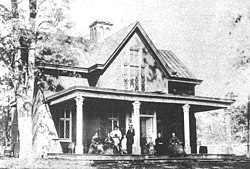
Edwin Thomas Booth was an American actor who toured throughout the United States and the major capitals of Europe, performing Shakespearean plays. In 1869, he founded Booth's Theatre in New York. Some theatrical historians consider him the greatest American actor, and the greatest Prince Hamlet, of the 19th century. His achievements are often overshadowed by his relationship with his younger brother, actor John Wilkes Booth, who assassinated President Abraham Lincoln.

Junius Brutus Booth was an English stage actor. He was the father of actor John Wilkes Booth, the assassin of U.S. President Abraham Lincoln. His other children included Edwin Booth, the foremost tragedian of the mid-to-late 19th century, Junius Brutus Booth Jr., an actor and theatre manager, and Asia Booth Clarke, a poet and writer.

The Johnston–Felton–Hay House, often abbreviated Hay House, is a historic residence at 934 Georgia Avenue in Macon, Georgia. Built between 1855 and 1859 by William Butler Johnston and his wife Anne Tracy Johnston in the Italian Renaissance Revival style, the house has been called the "Palace of the South." The mansion sits atop Coleman Hill on Georgia Avenue in downtown Macon, near the Walter F. George School of Law, part of Mercer University. It was designated a National Historic Landmark in 1973 for its architectural uniqueness.
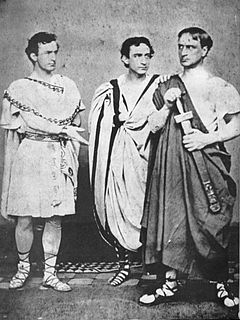
The Booth family was an English American theatrical family of the 19th century. Its most known members were Edwin Booth, one of the leading actors of his day, and John Wilkes Booth, who assassinated Abraham Lincoln.
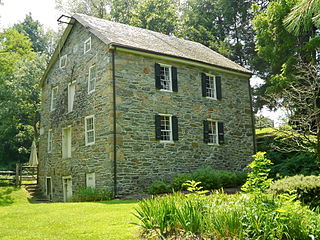
The Mill Green Historic District is a National Register of Historic Places listed community located in Harford County, Maryland. The district consists of a small cluster of privately owned historic homes and buildings including a historic mill. The district is located at the junction of Mill Green Road and Prospect Road. Broad Creek flows through the district. The historic district designation was established in 1993.

Darnall's Chance, also known as Buck House, Buck-Wardrop House, or James Wardrop House, is a historic home located at 14800 Governor Oden Bowie Drive, in Upper Marlboro, Prince George's County, Maryland, United States.

The Costen House is a historic U.S. home located at 206 Market Street, Pocomoke City, Maryland, United States. Dr. Isaac Thomas Costen built the house c. 1870s and members of his family lived there for over a century. Dr. Costen became the first Mayor of Pocomoke City. The house currently serves as The Isaac Costen House Museum.

Sion Hill is a National Historic Landmark in Havre de Grace, Maryland, notable as an example of high-style Federal architecture and as the home of a family of prominent officers of the United States Navy.
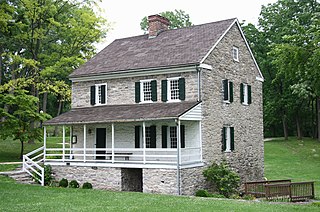
The Hager House is a two-story stone house in Hagerstown, Maryland, United States that dates to c. 1740. The house was built by Jonathan Hager, a German immigrant from Westphalia, who founded Hagerstown. The basement contains two spring-fed pools of water, providing a secure water source. Hager sold the property, then known as Hager's Fancy to Jacob Rohrer. The house remained in the Rohrer family until 1944, when it was acquired by the Washington County Historical Society. The restored house was given to the City of Hagerstown in 1954 and opened to the public in 1962 as a historic house museum.

Schifferstadt, Also known as Scheifferstadt, is the oldest standing house in Frederick, Maryland. Built in 1758, it is one of the nation's finest examples of German-Georgian colonial architecture. It was designated a National Historic Landmark in 2016.

The Beall–Dawson House is a historic home located at Rockville, Montgomery County, Maryland, United States. It is a 2+1⁄2-story Federal house, three bays wide by two deep, constructed of Flemish bond brick on the front facade and common bond elsewhere. Outbuildings on the property include an original brick dairy house and a mid-19th century one-room Gothic Revival frame doctor's office which was moved to the site for use as a museum. The house was constructed in 1815.
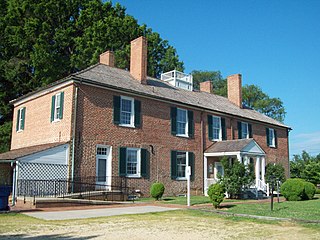
Tudor Hall is a historic home located at Leonardtown, St. Mary's County, Maryland. It is a large, rectangular, 2+1⁄2-story, Georgian brick building built about 1798. It is one of the oldest buildings in Leonardtown, which was created by the Maryland Legislature in 1720. It is home to the St. Mary's County Historical Society.

Rose Hill Manor, now known as Rose Hill Manor Park & Children's Museum, is a historic home located at Frederick, Frederick County, Maryland. It is a 2+1⁄2-story brick house. A notable feature is the large two-story pedimented portico supported by fluted Doric columns on the first floor and Ionic columns on the balustraded second floor. It was the retirement home of Thomas Johnson (1732–1819), the first elected governor of the State of Maryland and Associate Justice of the United States Supreme Court. It was built in the mid-1790s by his daughter and son-in-law.

The Price–Miller House is a historic home located in Hagerstown, Washington County, Maryland, United States. It is a 2+1⁄2-story, brick Neoclassical-style townhouse that rests on a high-cut stone foundation, and was built circa 1824–1825.

The Hays House is a historic home located at 324 South Kenmore Avenue, Bel Air, Harford County, Maryland, United States. It is a frame 1+1⁄2-story house with a gambrel roof, likely built in 1788 with an addition in 1811. The house was moved in 1960, and stands on a modern concrete-block foundation. The Hays House is owned by The Historical Society of Harford County and today the Hays House Museum offers visitors a glimpse into the life of an affluent family in late 18th century Bel Air.

Fair Meadows is a historic home located at Creswell, Harford County, Maryland. It is a 2+1⁄2-story Second Empire–style house constructed in 1868 for the last owner of Harford Furnace, Clement Dietrich. The house is constructed of irregularly laid ashlar and features a mansard roof, cupola, dormers with rounded hoods, and stone quoins. The interior has a center hall plan and includes intricate inlay designs, black and white marble tiles in the center hall, plaster ceiling ornaments and friezes, marble mantels, and original crystal chandeliers. Also on the property are the ruins of a round springhouse, a one-story stone carriage house, a brick smokehouse, and three hip-roofed coursed rubble stone outbuildings. The estate was later home to Eastern Christian College.

Olney, originally patented as Prospect, is a historic home and farm complex located at Joppa, Harford County, Maryland. It is a 264-acre (1.07 km2) working pony farm with a collection of 15 structures ranging in style, use, and elegance. The main building on the property is a 2+1⁄2-story brick house dating to 1810, generally called "the mansion." The house was evolved into a museum of Maryland architecture, with salvaged features from demolished buildings in Baltimore and Philadelphia. These include paneling from the Isaac Van Bibber house in Fells Point, Baltimore dating to 1815; the marble Ionic portico from William Small's Baltimore Athenaeum from 1830; and a marble bas-relief plaque designed by Pierre L'Enfant for Robert Morris's great 1795 house in Philadelphia. Also on the property is an early-18th-century, 2+1⁄2-story stone dwelling and a variety of still-functioning farm structures that in themselves range in style from simple stone stables and frame hay barns to an unusual two-story brick blacksmith's shop. In addition, the 1914 Union Chapel School, was moved onto the property in 1980 and re-outfitted as St. Alban's Anglican Church. The property was developed by J. Alexis Shriver (1872–1951), a man prominent in local and state historical and agricultural matters who lived at Olney from 1890 until his death.

Medical Hall Historic District is a historic home and national historic district near Churchville, Harford County, Maryland, United States. The home was constructed of stuccoed stone between 1825 and 1840 and is five bays long, two bays wide, and two and a half stories high. The façade features a centrally placed door with sidelights and a rectangular transom subdivided in a radiating pattern. Also on the property is a stone springhouse which 20th century owners have converted into a pumphouse and a stone cottage believed to be a 19th-century tenant house. The property is associated with John Archer (1741–1810), the first man to receive a degree in medicine in America. One of his sons was Congressman, judge of the circuit court, and Chief Justice of Maryland Stevenson Archer (1786–1848).

The Marian Anderson House is a historic home located in the Southwest Center City neighborhood of Philadelphia, Pennsylvania. Built circa 1870 in the same neighborhood where opera singer and civil rights advocate Marian Anderson was born 27 years later, this two-story, brick rowhouse dwelling was designed in the Italianate style. Purchased by Anderson in 1924, the same year she became the first African-American concert artist to record spirituals for a major American recording company, she continued to reside here until 1943. The house is currently home to the Marian Anderson Museum and Historical Society.
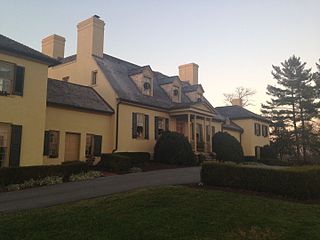
The Belmont Estate, now Belmont Manor and Historic Park, is a former forced-labor farm located at Elkridge, Howard County, Maryland, United States. Founded in the 1730s and known in the Colonial period as "Moore's Morning Choice", it was one of the earliest forced-labor farms in Howard County, Maryland. Its 1738 plantation house is one of the finest examples of Colonial Georgian architectural style in Maryland.
